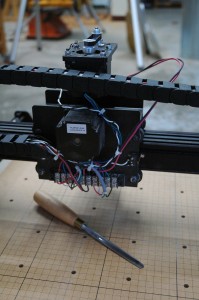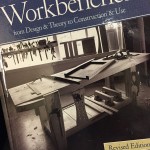We may receive a commission when you use our affiliate links. However, this does not impact our recommendations.
 Like most latchkey kids who grew up in the ’80s, I watch too much TV. If you are ever in my shop you’ll likely see a small TV on in the background. Do I really pay attention to it? Not really. I’ll catch 10 or 15 seconds, remember the plot and move on. It’s white noise – my generation’s version of an “El Lector” (reader) in a cigar factory.
Like most latchkey kids who grew up in the ’80s, I watch too much TV. If you are ever in my shop you’ll likely see a small TV on in the background. Do I really pay attention to it? Not really. I’ll catch 10 or 15 seconds, remember the plot and move on. It’s white noise – my generation’s version of an “El Lector” (reader) in a cigar factory.
You’d be amazed what a random brain input can do for your thought processes while woodworking. This week, I caught a minute of a “House” episode where the good doctor saved a patient’s life by looking in a microscope, one of the most analog of diagnostic tools. The doctor’s young team was relying on data from every whiz-bang quad-billion dollar device known to the medical world – but it was Dr. House’s creative thinking that saved the day. The young team’s imagination was limited by their reliance on technology.
This got me thinking: Is technology having the same limiting effect on imagination and thought as George Orwell’s Newspeak language in his “1984?”
I saw something like this in the technology classes I taught in a high school. By the time they reach high school, you can divide most students into two classes: doodlers and non-doodlers. When it came time for using “creative technology” such as imagery and design programs, I found that the doodlers had a huge advantage over non-doodlers. In my opinion, it wasn’t artistic skill that made the difference, but an analytical imagination.
The doodlers took their experience and applied it instantly to the technology. They knew what they wanted to do and sought the tool within the program to accomplish it. The non-doodlers began by trying to find out which tools were where in the program and what they did. The difference is subtle, but it affects what is made.
The doodlers made complex items with themes and meaning from the get-go, while the non-doodlers made lots of boxes, circles and squiggly lines. Both groups were new to the programs, but the non-doodlers were almost instantly held back by the limit to their imaginations’ language.
Ever wonder why the “Maker Movement” has exploded? Look at the demographics. The generation who grew up learning by buying and assembling kits is now at an age where they have more discretionary income and are having kids. Guess what they’re sharing – the ability to buy and assemble parts and kits into stuff. Granted, they might hack those parts before assembly, but they’re still assembling ready-made parts.
Tell me that the limited creative language of prefab parts doesn’t stifle imagination. Where will the inventors of our next generation come from if this IKEA method of “you must adhere to what’s available” thinking becomes the norm?
The moral I took from the “House” episode was that if you need a doctor, you want one with a diagnostic imagination that’s not limited to what the latest machine will do. I want a doctor, or for that matter any professional (architect, researcher, scientist, etc.…) who thinks of technology as just a steppingstone to a larger goal. And I don’t want future generations of woodworkers to give up on building a corner table because the box-joint jig only makes 90-degree corners.
The holiday season is almost upon us. So let’s do something a little different. This year, instead of a tablet or a smartphone, why don’t you buy yourself and your kid a weekend adventure or tool? Something to open up opportunities to practice and expand thinking creatively; something that’ll allow him or her to exercise the imagination in ways normal life doesn’t.
Being a woodworker, I suggest giving you and your kids the chance to learn something new. Sign up for a weekend class on basic joinery, then build a new bedroom set together – or a backyard Millennium Falcon treehouse! Whatever it is, make sure it’s a gift you can do together. It’s important to exercise and expand creativity, but it’s also important to demonstrate that this is a lifelong developmental process.
And in the world of Newspeak thinking, the kids with expanded creative resources will be the ones with a leg up on the minions.
Start prepping now. I’d like to hear your ideas on other woodworking gifts to share with the next generation with the goal of unlocking their creative thought processes. Share your ideas and thoughts in the comments section below and let’s discuss.
Here are some supplies and tools we find essential in our everyday work around the shop. We may receive a commission from sales referred by our links; however, we have carefully selected these products for their usefulness and quality.









“Tell me that the limited creative language of prefab parts doesn’t stifle imagination.”
The generation before ours said the exact same thing about TV. That argument is as silly now as it was then. Creativity is different, it is learned differently and expressed differently. Who are you or I to define it, or divide people into categories of our own making? Doodler or non-doodler. Creative or Ikea-loving minion. Judging people and activities to be artistic or inartistic has killed more creativity than any amount of pre-fab parts ever could.
Shawn,
I too have this same fear! My daughter is a few years out of high-school now, but I can remember when she came home with “her” woodworking project (a deck chair) that she told me was in fact made by the class in an assembly-line type arrangement…she wasn’t even sure if she did any of the work on this particular chair! It turns out that the job the teacher assigned to her and another student was to sand the chair arms, while other students either sanded or assembled various parts…all the cutting was done by the teacher. (I can only assume that was due to safety concerns?) She also did a few other similar projects, (such as a tool-tote made out of MDF…that thing weighed at least 10 pounds empty, and the internal compartment barely held a hammer.) I’ve become a real advocate for unplugged woodworking, and have just recently started teaching a few local kids how to make things like benches and simple furniture without resorting to power tools. It is still very early days, but I am really looking forward to seeing what some of these kids do when we allow them to really ‘doodle’ in 3 dimensions with wood!
Tech is certainly a two bladed sword, but I have found more of the opposite to be the case. Lots of guys my age and older don’t feel like they made anything unless it was cut with a hand saw or at the most a basic power saw.
Tech., CNC, mostly does the opposite of what you claim. Frees the maker from the tedium of hours of manual cutting to do some serious design work. I can sketch out a simple project on a piece of graph paper when I have to, but I am grateful to the guy that encouraged me to bust through the learning curve of Sketchup and us it most of the time. I now catch 95% of my design mistakes before ruining good wood.
That said, no matter how well I like my smart tools, there is a time and place for a cold chisel or coping saw.
I wonder sometimes what the future of woodworking will look like. Does it have room for the old school? I am not too sharp with sketchup. It takes me too long to draw out a curved back chair leg pattern I am happy with and when I finally get it, I can’t print it out. So I rely on a wide roll of paper to draw out my patterns. The upcoming generation is so computer based, I wonder if they will be able to function unplugged. I for one don’t want to become a computer wiz to work with wood. It is a tool and any tool you can add to your tool kit is helpful, but these tools have been only a blip in the timeline of woodworking and yet seem to dominate the arena. I am not computer illiterate, I have a small cnc, but I don’t want to rely on it either. Especially in design, you should never let the tool define your design parameters. It seems like to teach woodworking now or be in the current flow you need to speak CAD. I fear I will go the way of the dinosaur on this one. Great article, we need to nurture more doodlers and turn the power off on them once in a while to see what they do.
Excellent article. There’s a lot about the “maker movement” that is great, but a lot of it that I don’t. I think you nailed a few points. Technology can be great for makers but can also stifle imagination. I saw a recent youtube video where a guy made an attractive, but basic object out of wood using a CNC. He stated several times that this would be nearly impossible to do without a CNC. What? Have you looked at any furniture built in the lat 500 years? Most of it by hand and 100x more ornate than what you just made. But at least that guy created the design himself. Others download a pre-made design into a machine and press start and feel like they’ve created something.